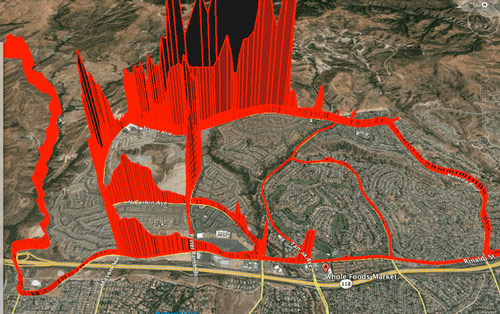The "Fukushima class disaster" that emerged from Aliso Canyon's worst ever gas leak has left behind more than just medical and human issues. According to RealtyTrac, in the three months following the discovery of the gas leak in late October 2015, home sales in the Porter Ranch zip code (91326) plunged 44%, and "market disruption is further signified by the number of families that requested relocation out of the Porter Ranch area."
As a reminder of just what happened in the Porter Ranch area…
"the enormity of the Aliso Canyon gas leak cannot be overstated. Gas is escaping through a ruptured pipe more than 8,000 feet underground, and it shows no signs of stopping,"
The following map shows the spread of methane over the Los Angeles area and researchers from Eco Watch report that elevated levels of natural gas have been detected as far as 10 miles from the leak:

And residents in the Porter Ranch are are suffering significant health problems…
On February 18, SoCalGas and the national media declared the “worst methane gas leak in U.S. history” permanently sealed, but just over a month later, hundreds of Porter Ranch residents who evacuated — and are now returning home — are suffering the same symptoms they suffered when the gas leak was active. They are experiencing nausea, dizziness, fatigue, headaches, nosebleeds, and many, including children, are also experiencing a new ailment: irritated skin rashes across their bodies.
Neither SoCalGas, which owns the Aliso Canyon facility, the Los Angeles County Department of Public Health, nor any other government agency has provided a concrete explanation for these continued symptoms. In fact, one of Los Angeles County’s top medical officials recently told local physicians to refrain from performing tests to determine what is causing the symptoms. Late last week, preliminary lab tests from an independent UCLA study found evidence of benzene, a carcinogen, in at least two Porter Ranch homes. Benzene was reported to have been released in the 100 metric tons of methane that spewed into the Los Angeles basin for four months — a fact SoCalGas previously attempted to downplay and withhold.
…
Gabriel Khanlian, a resident who serves as the Chief Technology Officer for Save Porter Ranch, a group formed in 2014 to fight the massive, aging, and leaking facility before the blowout even happened, also said he and his family have suffered symptoms since moving home.
“My daughter Tatiana keeps getting large rashes, red welts and bumps all over her body. Her skin is dry and her behavior has changed significantly and she is very cranky. She has a loss of appetite and is sleeping a lot more,” he said. “My sons, Jayden and Mason, have been getting bloody noses, headaches, upset stomachs, burning eyes, runny nose, dry skin.”
He described other troubles they’ve had, noting his sons are experiencing “anxiety, fear, frustration, anger, and stress from not having the ability to play. Their personalities have changed majorly.”
He said his wife, who experienced symptoms during the initial methane gas leak, is now experiencing them more severely than before.
So it is likely no surprise that, as RealtyTrac reports,
The Porter Ranch analysis shows that in the three months following the discovery of the gas leak in late October 2015, home sales in the Porter Ranch zip code (91326) plunged 44 percent while the share of all-cash sales spiked 50 percent during the same time period. Meanwhile, the median home sales price in Porter Ranch in the three months following the discovery of the gas leak dropped 1 percent.
“Such a spike in the percentage of cash sales in an area in such a short period of time certainly indicates a market disruption,” said Dr. Clifford A. Lipscomb, Director of Economic Research at Greenfield Advisors. “Market disruption is further signified by the number of families that requested relocation out of the Porter Ranch area as well as the number of health effects reported by area residents. Also, with further research, you might find that lenders are less willing to lend on a property located in the Porter Ranch area.”
“While median home prices have somewhat surprisingly held steady in the wake of the gas leak discovery, the sharp drop-off in sales paired with the spike in cash sales indicates quickly eroding demand for homes in Porter Ranch, particularly from buyers who rely on financing — far and away the majority of buyers in the housing market,” said Daren Blomquist, senior vice president at RealtyTrac. “The impact of the gas leak is even clearer when sales within the ZIP code are plotted on a map. Sales north of Highway 118 — closer to the actual gas leak where higher levels of methane have been documented — are down 60 percent, while sales south of the 118 are down 14 percent.”
RealtyTrac also calculated the potential impact on other local housing markets from 319 underground natural gas storage facilities across the country.
Out of the 117 million homes available for search on RealtyTrac’s property pre-diligence website, www.HomeDisclosure.com, 4,826,374 (4 percent) worth an estimated $1.3 trillion in cumulative market value are within a 10-mile radius of an underground natural gas storage facility like the one that leaked in Porter Ranch.
(click image for link to interactive version)
The website allows consumers to find out if a home they own or are interested in buying is within a 10-miles radius of an underground natural gas storage facility and provides detailed information about each of these facilities.
The post Residents Flee, Home Sales Collapse 44% Following Biggest Gas Leak In History appeared first on crude-oil.top.




